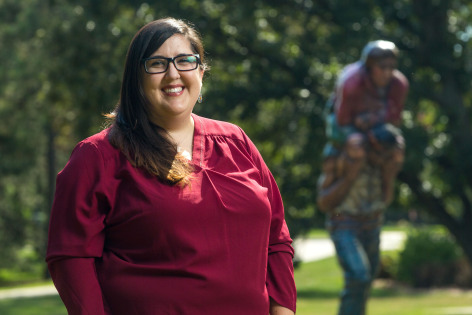
Erin Doran says even small changes can have a meaningful impact and help Latina/o students pass developmental education courses. (Larger image) Photo by Ryan Riley
AMES, Iowa – Erin Doran knows change is never easy, even with evidence illustrating why the current approach to developmental education is not working for many students.
Doran, an assistant professor in Iowa State University’s School of Education, has developed a framework to better serve Latina/o students needing extra preparation before they enroll in college-level courses. She points to the disproportionate number of Latina/o students who take developmental education courses (as many as 75 percent at two-year colleges and 53 percent at four-year schools) combined with the low percentage (just over a third in some studies) who pass and advance, as evidence for change.
“There is an awareness that developmental education is a barrier for all students,” Doran said. “What’s interesting to me is that we know it is a problem, but there are not a lot of people talking about Latina/o students caught in developmental education.”
Understanding that fundamental changes take time and often money, Doran focused her framework on a series of small, incremental changes – specifically for language and writing courses – that are relatively simple to implement and have the potential to yield significant results. Doran says it is not a one-size-fits-all solution. It is dependent on individual colleges recognizing and responding to needs of Latina/o students in developmental education courses.
In the paper, published by the Association of Mexican American Educators Journal, Doran explained the benefits of building a culturally responsive curriculum for Latina/o students. She also stressed the need to have an “open and frank conversation” with students about the purpose of developmental courses. Many Latina/o students are first generation and may not understand why they have to take the class, that they do not earn college credit or that they have to pay to retake it if they fail, Doran said.
Eliminating English-only focus
Meaningful assignments and textbooks help engage students in learning, Doran said. That is why she recommends developmental instructors rework their reading and writing assignments with their students in mind. Instead of following the same template each semester, incorporate books and essays that are culturally relevant to students in the class, she said. Instructors also should give students flexibility to communicate in their home language, when appropriate.
Doran says this does not change the goal of helping Latina/o students become proficient in English, but an English-only focus can have unintended consequences:
- Students feel pressure to perfect the English language, rather than develop bilingual skills
- Students feel they have to give up a part of their identity to fit in on a college campus
- Students feel discouraged when the meaning of what they are saying is lost in translation
For these reasons, Doran suggests instructors find a balance.
“If you acknowledge a student’s home language, you show them the power of being bilingual. Students need to come out of these classes with a specific set of skills, but why not let them experiment in different ways with language? Rather than assigning dry, boring readers that are so common in developmental courses, give students work that speaks across cultures,” Doran said. “This goes beyond benefits for students of color; it really benefits any student who struggles with reading.”
Universal themes, empathy
Through her research, Doran interviewed an instructor in Houston who used memoirs to teach a class on the minority experience. The instructor was intentional in selecting stories that represented different cultures, but also focused on common issues or themes, such as family or belonging.
The instructor’s approach showed students they are more alike than different, Doran said. It also was a more useful and productive exercise than the assignments Doran found in some of the commonly used textbooks for developmental classes. For example, one assignment asked students to write about why they would rather take a limo ride with Barack Obama or Kim Kardashian. Doran says not only is it an unrealistic experience for most students, but some Latina/o students may not know anything about Kardashian to make a choice.
Within her framework, Doran also identifies ways for instructors to relate with students and make them feel welcome on campus. Simply expressing empathy or understanding the difficulty of learning another language can go a long way, she said. Faculty of color – especially those who have learned a second language – can serve as advocates and role models for students to see how their hard work will pay off.
Doran recognizes that incorporating every aspect of the framework may not be practical or necessary. She expects any change to be incremental and gradually embedded in the teaching, curriculum and advising.
“The framework I’ve proposed may seem like common sense to some. There are teachers who know these things from their own observations and experience,” Doran said. “Really this is more about how we can make this a call to action for the field and not just individual teachers.”
Contacts
Erin Doran, School of Education, edoran@iastate.edu, 515-294-3748
Angie Hunt, News Service, amhunt@iastate.edu, 515-294-8986
Quick look
A disproportionate number of Latina/o students who take developmental education courses never pass and advance to college-level courses. That's why Erin Doran, an assistant professor of education, has developed a framework to better serve Latina/o students needing extra preparation.
Quote
“There is an awareness that developmental education is a barrier for all students. What’s interesting to me is that we know it is a problem, but there are not a lot of people talking about Latina/o students caught in developmental education.”
Erin Doran, assistant professor in Iowa State University’s School of Education